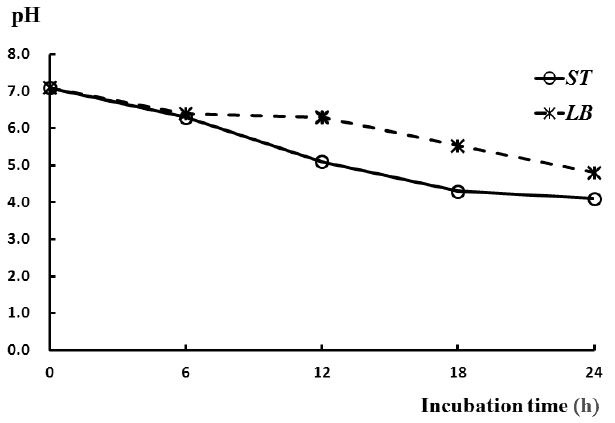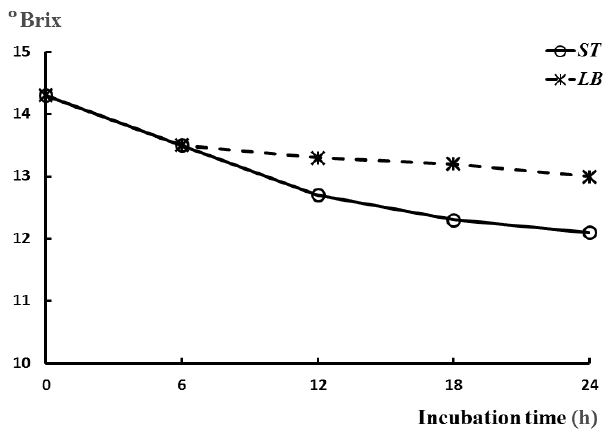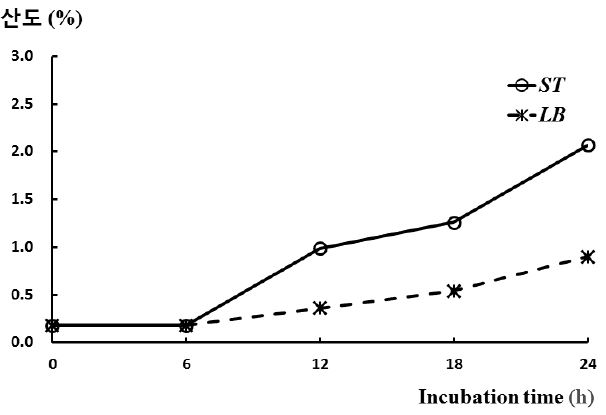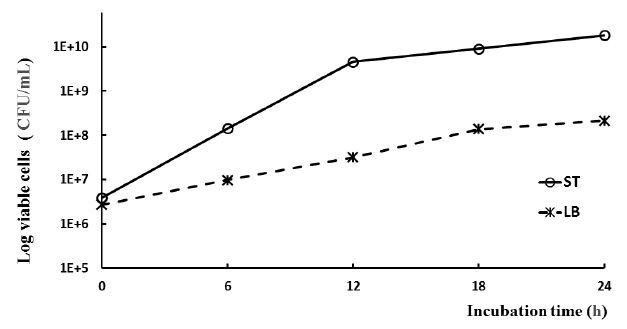
국내산 대두의 불용성 물질을 포함한 두유 요구르트의 발효 및 품질 특성
Abstract
The objective of this research was to determine the fermentation and quality properties of soy yogurt incorporating insoluble components fermented with Streptococcus thermophilus (S. thermophilus) and Lactobacillus bulgaricus (L. bulgaricus) for 24h. Boiled soybeans were ground and reconstituted into equivalent total solids (18%). After soymilk was homogenized with sugar, it was pasteurized in a water bath at 90℃ for 30 min. Two kinds of lactic acid bacteria were inoculated into two types of soymilk after cooling down 40∼45℃ and fermentation at 37℃ for 24h. Titrable acidity, pH, viscosity, sugar content, and number of viable cells were determined in triplicate. Soy yogurt fermented with L. bulgaricus did not reach pH 4.5, where as S. thermophilus was considered good for achieving pH 4.08 and titratable acidity of 2.27% for 24 h. Soy yogurt fermented with S. thermophilus had a higher viscosity and lower sugar contents than that fermented with L. bulgaricusas incubation time increased. Total viable count was 1.80 × 1010 CFU/mL on S. thermophilus and 2.16 × 108 CFU/mL on L. bulgaricus after 24 h at 37℃. However, there was no significant difference in sensory intensities and preference between the two samples. As a result, S. thermophilus was identified as a better culture than L. bulgaricus for the manufacture of soy yogurt incorporating insoluble components.
Keywords:
Soy yogurt, fermentation characteristics, insoluble components, domestic soybean, sensory evaluation서 론
최근 생활수준의 향상과 서구화에 따른 식생활 패턴의 변화로 인해 심혈관계 질환과 호르몬 관련 질환의 증가뿐만 아니라, 급속한 고령화 사회 진입과 건강 중시 경향으로 인한 식생활에 대한 관심이 급격히 증가하고 있는 추세이다(Kim JS 1989). 요구르트는 우유를 유산균으로 발효시켜 산미와 향미를 강화시킨 것으로 lactate, peptone, peptide, 미량의 생리활성물질들이 포함되어 있어 생리 기능성이 뛰어나 현대인들에게 각광받고 있는 식품이다(Jung GT & Ju IO 1997). 2006년 미국 Health 잡지가 뽑은 세계적인 건강식품 5가지 중 3가지가 발효식품인 김치, 장류, 요구르트가 선정되어 국제적으로도 요구르트는 건강식품으로 인식되고 있다(Park KY 2012). 특히 요구르트의 건강 증진 효과로는 유산균의 장내 증식에 의한 정장 효과(Hood SK & Zottola EA 1998), 장내 균총의 정상화에 의한 소화기 건강(Mistuoka T 1990), 혈중 콜레스테롤 저하 작용(Kim DW 등 2009; Rasic JL & Kurmann JA 1978), 장내 유해세균의 생육억제, 유당 소화흡수의 촉진 및 대장암 발생률 저하 등의 효과가 있는 것으로 보고된 바 있다(Robinson IM 등 1984; Savaiano DA 등 1984).
대두는 곡식이지만 육류에 가까운 성분을 가지고 있기 때문에 밭에서 나는 육류라고 부르고 있다. 대두에는 isoflavone, lecithin, 섬유소 등과 같은 건강 증진용 물질이 풍부하고, 식물성 고단백 식품으로 영양학적으로 아주 우수한 소재로 saponin, phytic acid, isoflavones, hemaglutinins 등의 다양한 생리활성물질을 포함하고 있어 암을 비롯한 성인병 예방 및 치료에 대한 가능성이 보고되고 있다(Yoo JH & Yeo IH 2008). 대두 단백질은 용해도, 점도, 점착력 및 아미노산 조성 등의 여러 가지 성질이 우유단백질과 유사하기도 하지만(Klara S 1950), lysine의 함량이 높아 곡류 위주의 식생활을 하는 지역에서 우수한 단백질 급원으로 권장되는 식품이다. 최근 한국은 급속한 고령화 사회의 진입으로 인하여 건강 증진용 식품에 관심이 높아지고 있는 소비자들의 요구에 따라 기호성 및 영양적 범위를 벗어나 건강을 중시하고자 하는 다양한 요구르트를 개발하고자 하는 노력이 이루어지고 있으며(Chung HJ 등 2010), 특히 기능적인 측면을 강화하려는 노력으로 천연소재가 첨가된 요구르트들이 출시되고 있다(Ahn CS 등 2009). 두유 요구르트는 기존의 우유 요구르트에 비해 가격이 저렴할 뿐만 아니라, 영양도 우수하여 국민 건강기능 향상에 크게 기여할 수 있어(Bae HC & Nam MS 2005) 지금까지 불용성 물질 등을 제거한 두유를 이용한 요구르트에 대한 연구는 많이 이루어져 왔다(Kanda H 등 1976; Seong WH 등 1984; Shin S-M 등 2012; Yang M 등 2013). 현재 두유 요구르트는 대두를 물과 함께 마쇄할 때 대두에 함유되어 있는 불용성 식이섬유와 탄수화물 등의 각종 유용한 성분들이 교질현탁액을 이루는데, 이러한 유용한 성분들이 함유되어 있는 불용성 물질의 대부분은 배제되고, 수용성 물질이 주가 되는 두유를 이용하여 요구르트를 제조하고 있다. 하지만 대두에 많이 들어있는 불용성 식이섬유는 소장의 콜레스테롤을 흡착하여 체외로 배출하는 기능이 뛰어나며, 불용성 탄수화물 또한 다양한 생리활성 성분을 포함하고 있어 대장의 생리에 영향을 주어 변비 치료와 같은 효과가 있음에도 불구하고, 대두의 불용성 물질을 활용한 두유 요구르트의 제조 및 특성에 대한 연구는 거의 이루어지지 않고 있는 실정이다. 따라서 본 연구에서는 국산 대두를 직접 갈아 불용성 물질을 포함한 두유에 2종의 유산균주(Lactobacillus bulgaricus, Streptococcus thermophilus)를 접종하여 발효시키는 동안의 이화학적 특성 변화를 확인하고 제조된 두유 요구르트의 품질 특성에 대한 연구를 수행하고자 하였다.
재료 및 방법
1. 사용 균주 및 배양
불용성 물질을 포함한 두유 요구르트 제조에 사용된 균주는 Lactobacillus delbrueckii subsp. bulgaricus(이하 L. bulgaricus)와 Streptococcus thermophilus(이하 S. thermophilus) 2종의 균주를 사용하였으며, 보존용 배지로는 Lactobacilli MRS broth 배지(Difco Laboratories, Becton, Dickinson and Company, Sparks, MD, USA)에서 37℃, 24시간 2회 계대 배양하여 종균으로 사용하였다. 1차 균주 배양은 5.2% MRS 배지에 0.2% 접종하여 37℃에서 24시간 배양하였으며, 같은 조건에서 2차 계대 배양한 균주를 요구르트 제조의 스타터로 사용하였다.
2. 두유 요구르트 제조
두유 요구르트의 주원료인 백태(광주시 서구 매월동)는 홈마트(군산시 미룡동)에서 구입하여 사용하였다. 불용성 물질을 포함한 두유의 제조에는 800 mL의 물에 선별한 건조대두 200 g을 2시간 이상 침지시키고, 1시간 정도 끓여낸 후 냉각시킨 대두를 원액기(SJ-200B, Hurom, Gimhae, Gyeongnam, Korea)에 물과 함께 넣어 갈아 나온 두유 원액을 물로 희석하여 고형분 18% 정도로 조정한 두유를 제조하였다. 제조한 두유에 10%(w/v) 설탕을 첨가하여 water bath에서 90℃로 15분간 살균하고 냉각하여 실험에 사용하였다. 불용성 물질을 포함한 두유에 L. bulgaricus와 S. thermophilus 균주 0.5%(v/v)를 각각 접종하여 37℃에서 24시간동안 배양하면서 6시간마다 pH, 적정산도, 당도, 점도, 유산균수를 측정하여 비교하였다.
3. pH 및 적정산도 측정
불용성 물질을 포함한 두유 요구르트의 pH는 pH meter (Orion 2 Star, Thermo Fisher Scientific Inc., Beverly, MA, USA)로 측정하였으며, 적정산도는 Jeon 등(2005)의 방법에 따라 1% 페놀프탈레인 0.2 mL를 첨가하고, 0.1 N NaOH로 적정하여 측정하였으며, 그 소비 mL수를 다음의 계산식을 이용하여 젖산으로 환산하였다.
4. 당도, 색도, 점도 측정
불용성 물질을 포함한 두유 요구르트의 당도는 굴절당도계(PR-210α, ATAGO Co. Ltd., Tokyo, Japan)를 이용하여 측정하였고, 색도는 유산균 접종 직후와 24시간 동안 발효 후 각각의 시료를 색도 비색계(CM-5, Konica Minolta, Tokyo, Japan)로 L값(lightness), a값(+red/-green), b값(+yellow/-blue)으로 나타내었다. 또한 점도는 진동형 점도계(SV-10, AND Company, Ltd., Tokyo, Japan)를 이용하여 측정하였으며, 모든 실험은 3회 반복 측정하여 평균값으로 나타내었다.
5. 유산균수의 측정
불용성 물질을 포함한 두유 요구르트의 배양 중 유산균의 변화 측정은 24시간 동안 배양하면서 6시간마다 채취한 샘플을 멸균 생리식염수에 넣고 균질화한 후 십진 희석법으로 희석하여 Petri dish에 시료를 분주하고, MRS agar 배지(Difco Laboratories, Becton, Dickinson and Company, Sparks, MD, USA)와 혼합한 다음, 37±1℃에서 2일간 배양하여 나타난 colony 수를 측정하여 log colony forming unit(CFU/mL)로 환산하여 표시하였다(Chung IK 등 2006).
6. 관능평가
불용성 물질을 포함한 두유 요구르트의 관능 평가를 위하여 발효 후 냉장고에 2일간 보관한 두유 요구르트의 관능적 특성 강도는 학생 및 교직원 47명의 소비자 패널을 대상으로 하였으며, 9점 항목 척도(nine point category scale)로 평가하였다(Kim HY 등 2009). 특성 강도 평가 시에는 1점일수록 특성의 강도가 약해지고, 9점일수록 강도가 강해지는 것을 나타내도록 하였다. 관능적 특성이 발현되는 순서에 따라 노란색의 정도, 콩 비린내의 정도, 신맛, 단맛, 콩맛(두유의 맛), 부드러운 정도, 끈적이는 정도를 평가하도록 하였다. 기호도 검사는 47명이 소비자 패널로 9점 척도법(nine point hedonic scale)으로 평가하였으며, 평가 시 1점(대단히 싫다)에서 9점(대단히 좋다)까지 점수를 부여하도록 하였다. 평가항목으로는 외관(Appearance), 냄새(Flavor), 맛(Taste), 조직감(Texture), 전반적인 기호도(Overall acceptability)에 대하여 평가하였다.
결과 및 고찰
1. 두유 요구르트의 발효 중 pH 및 적정산도의 변화
불용성 물질을 포함한 두유를 이용한 요구르트 제조 시 24시간 동안 pH의 변화에 대하여 Fig. 1에 나타내었다. 각 시료의 pH는 발효시간이 증가하면서 점차 낮아지는 경향을 보였지만 S. thermophilus를 이용한 두유는 18시간 후에 pH 4.5 근처에 도달하였으나, L. bulgaricus로 배양한 경우에는 완만하게 감소하여 24시간 후에도 pH 4.5에 미치지 못하였다. Mital BK & Steinkraus KH(1997)는 Soymilk의 발효에 S. thermophilus 균주가 가장 산 생성이 탁월한 유산균 culture라고 보고하였다. 요구르트 제조 중 가장 중요한 화학적 변화는 요구르트의 풍미를 향상시킬 수 있는 lactic acid의 생성으로 알려져 있는데, Fig. 2에서 보는 바와 같이, S. thermophilus를 접종하여 발효시킨 두유 요구르트의 lactic acid의 생성량은 배양 12시간 이후 급격히 증가한 반면, L. bulgaricus로 배양한 경우에는 완만하게 증가하는 경향을 나타내었는데, 이러한 결과는 pH 분석에서 나타난 결과와 일치하였다. 일반적으로 유산균으로 발효한 발효유의 경우 산도가 1.0∼1.1%일 때 가장 양호한 품질을 가진다고 보고하였는데(Shin YS 등 1983), L. bulgaricus 균주의 경우 접종 후 24시간까지도 산도가 1.0%에 도달하지 못하였으며, S. thermophilus 균주를 접종하였을 때는 18시간쯤에 산도가 1.0% 이상 올라간 것으로 보아, 두 가지 유산균 중에는 S. thermophiles 균주가 불용성 물질을 포함한 두유 요구르트의 발효에 적합한 결과를 나타내었다.

The change of pH on soy yogurt incorporating insoluble components during fermentation period by S. thermophilus and L. bulgaricus at 37±1℃ for 24 h.ST (○) : soymilk yogurt fermented with Streptococcus thermophilus, LB (✳) : soymilk yogurt fermented with Lactobacillus bulgaricus.
2. 두유 요구르트의 발효 중 당도, 점도, 색도의 변화
불용성 물질을 포함한 두유 요구르트의 발효 중 당도의 변화에 대하여 측정한 결과를 Fig. 3에 나타내었다. 발효 시작 전의 당도(0시간)는 14.3 °Brix이었으나, 발효시간이 경과함에 따라 당도가 감소하는 경향을 확인할 수 있었는데, S. thermophiles 균주를 접종한 경우에는 6시간 이후 당도가 급격하게 감소하는 경향을 나타내었지만, L. bulgaricus로 배양한 경우에는 상당히 완만하게 감소하였다. 이는 발효기간 동안 유산균에 의해 당이 분해 및 감소되고, 유산 및 초산 등이 생성되어 적정한 산도를 가지는 대신 당도는 상대적으로 감소하는 것으로 생각되는데, S. thermophiles 균주를 접종한 두유의 발효 속도가 빠르다는 것을 알 수 있는 결과이다. 불용성 물질을 포함한 두유 요구르트의 발효 중 점도 변화를 측정한 결과, S. thermophilus를 접종한 경우에 발효 시작 6시간 이후 급격히 증가하는 경향으로 나타나 L. bulgaricus보다 두유의 점도 상승에 효과적이라는 결과를 Fig. 4에 보여주고 있다. 따라서 불용성 물질을 포함한 두유 요구르트는 S. thermophilus를 접종한 경우에 L. bulgaricus를 접종하였을 때에 비해 당도는 빠르게 감소하고, 점도는 증가하는 현상으로 보아 S. thermophilus 균주가 불용성 물질을 포함한 두유의 분해에는 더 효과적인 것으로 생각된다. 이는 Kim J-Y 등(2013)의 대두 요구르트에서 발효기간 동안 요구르트의 당도가 유의적으로 감소하였다는 보고와 일치하였다. 불용성 물질을 포함한 두유 요구르트의 발효 전후의 색도 변화를 측정한 결과는 Table 1과 같다. 전반적으로 밝기를 나타내는 L값은 발효 후 유의적으로 증가하였으나, 적색도인 a값과 황색도인 b값은 감소하는 경향으로 나타나, 불용성 물질을 포함한 두유 요구르트의 경우 발효가 진행되면 밝기는 증가하고, 적색 및 황색은 감소한다는 것을 알 수 있었다.

The change of sugar content on soy yogurt incorporating insoluble components during fermentation period by S. thermophilus and L. bulgaricus at 37±1℃ for 24 h.ST (○) : soymilk yogurt fermented with Streptococcus thermophilus, LB (✳) : soymilk yogurt fermented with Lactobacillus bulgaricus.

The change of viscosity on soy yogurt incorporating insoluble components during fermentation period by S. thermophilus and L. bulgaricus at 37±1℃ for 24 h.ST (○) : soymilk yogurt fermented with Streptococcus thermophilus, LB (✳) : soymilk yogurt fermented with Lactobacillus bulgaricus.
3. 두유 요구르트의 발효 중 유산균수의 변화
불용성 물질을 포함한 두유 요구르트 제조시 유산균주의 종류에 따른 생균수 변화를 측정한 결과는 Fig. 5와 같다. 배양시간이 경과함에 따라 생균수가 점차 증가하는 경향이 나타났는데, S. thermophilus를 접종한 경우가 6시간 이후 급격히 증가하여 12시간에는 4.56 × 109, 24시간에는 1.80 × 1010 CFU/mL인데 비하여, L. bulgaricus를 접종한 두유의 경우에 는 서서히 증가하여 발효 후 12시간에 3.18 × 107, 24시간에는 2.16 × 108 CFU/mL로 S. thermophilus를 접종한 경우보다 유산균수가 현저히 적게 나타났다. 불용성 물질을 포함한 두유 요구르트를 제조하는 동안 L. bulgaricus 균주를 접종한 경우에 비해 S. thermophilus 균주를 접종하였을 때 유산균수가 현저히 증가하는 결과가 나타났는데 이는 pH, 적정산도, 당도, 점도 등의 이화학적 실험 결과들과 일치하는 경향으로 나타났다. 하지만 우리나라의 축산물가공기준 및 성분 규격에 정해진 호상 요구르트의 총 유산균 수는 1.0 × 108 CFU/mL 이상으로 본 실험결과, 두 가지 유산균을 사용하여 제조된 두유 요구르트의 유산균수는 적정치 범위 이상인 것으로 나타났다.
4. 두유 요구르트의 관능 특성
불용성 물질을 포함한 두유 요구르트의 관능적 특성 강도를 알아보기 위하여 노란색의 정도(Yellowness), 콩 비린내의 정도(Beany flavor), 신맛(Sourness), 단맛(Sweetness), 콩맛(두유의 맛: Beany taste), 부드러운 정도(Softness), 끈적이는 정도(Thickness)에 대하여 9점 척도법으로 관능검사를 실시한 결과는 Table 2와 같다. 유산균주(L. bulgaricus와 S. thermophilus)의 차이가 모든 항목에서 불용성 물질을 포함한 두유 요구르트의 관능적 특성 강도에는 유의적으로 큰 차이를 나타내지 않는 것으로 나타났다. 또한 외관(Appearance), 냄새(Flavor), 맛(Taste), 조직감(Texture), 전반적인 기호도(Overall acceptability)에 대하여 9점 척도법으로 47명의 패널을 대상으로 기호도 평가를 실시한 결과를 Table 3에 나타내었다. 그 결과, 모든 기호도 항목에서 두 가지 유산균에 따른 유의적 차이가 나타나지 않아 유산균주의 변화가 불용성 물질을 포함한 두유 요구르트의 관능특성에는 큰 영향을 미치지 않는 것으로는 나타났지만, 표준편차의 차이가 크게 나타나는 것으로 보아, 불용성 물질을 포함한 두유 요구르트는 개인의 선호도에 따라 극명하게 갈리는 것으로 생각되어, 향후 연령별, 성별 등에 따른 선호도의 차이에 대한 연구가 더 필요할 것으로 생각된다.

Sensory intensities of soymilk yogurt including insoluble components fermented with S. thermophilus and L. bulgaricus
요약 및 결론
본 연구에서는 단백질 성분이 풍부한 대두를 물과 함께 마쇄하여 유용한 성분들이 함유되어 있는 불용성 물질을 활용한 두유 요구르트의 품질 특성을 파악하고자 2종의 유산균주(L. bulgaricus, S. thermophilus)를 접종한 두유 요구르트의 배양시간 동안 pH, 적정산도, 당도, 점도, 유산균수의 변화를 측정하고, 발효가 끝난 후 색도 측정 및 관능평가를 실시하였다. 배양시간이 경과함에 따라 pH는 낮아지고, 적정산도는 높아졌는데, S. thermophilus를 접종하였을 경우에는 18시간 후에 pH 4.5 근처에 도달하였으나, L. bulgaricus로 배양한 경우에는 24시간 후에도 pH가 5.0 정도밖에 도달하지 못하였으며, 적정산도의 경우에도 pH의 결과와 유사한 경향을 나타내었다. 또한 불용성 물질을 포함한 두유에 L. bulgaricus를 접종하였을 때에 비해 S. thermophilus를 접종하였을 때 당도는 빠르게 감소하고, 점도는 현저히 증가하는 현상이 나타났으며, 유산균수의 변화도 L. bulgaricus를 접종한 경우에는 서서히 증가하여 S. thermophilus를 접종한 경우보다 발효시간에 따른 유산균수가 현저히 적게 나타났다. 발효 전후의 색도 측정 결과, 유산균주의 변화에 따른 색의 차이는 나타나지 않았으며, 발효가 진행되면 밝기는 증가하고, 적색 및 황색은 감소한다는 것을 알 수 있었다. 관능평가의 결과에 따르면 유산균주의 종류(L. bulgaricus와 S. thermophilus)에 관계없이 관능적 특성 강도 및 기호도 평가의 모든 항목에서 유의적으로 큰 차이를 나타내지 않아 불용성 물질을 포함한 두유 요구르트의 경우에는 유산균주의 차이가 관능 특성에는 큰 영향을 미치지 않는 것으로 나타났다. 이상의 결과를 종합하여 볼 때 불용성 물질을 포함한 두유 요구르트는 유산균주의 차이가 관능적 특성 강도 및 기호도에서는 유의적으로 크게 차이를 나타내지는 않았지만, 발효 과정의 측면에서 볼 때에는 L. bulgaricus에 비해 S. thermophilus가 불용성 물질을 포함하고 있는 두유 요구르트의 제조에는 더 적합한 유산균주인 것으로 판단된다.
References
- Ahn, CS, Yeo, JS, Bang, IS, (2009), Physicochemical characteristics of fermented milk containing mulberry leaf extract, Korean J Food Nutr, 22(2), p272-278.
- Bae, HC, Nam, MS, (2005), Fermentation properties of the mixed yogurt prepared with bovine milk and soybean milk, Korean J Food Sci Ani Resour, 25(4), p483-493.
- Chung, HJ, Chu, YR, Park, H, Jeon, IS, Kang, YS, (2010), Influence of the addition of MACA (Lepidium meyenii) hot water extract on the quality and antioxidant activity of yogurt, J Korean Soc Food Cult, 25(3), p334-341.
-
Chung, IK, Kim, HS, Kang, KT, Choi, JD, Heu, MS, Kim, JS, (2006), Preparation and characterization of enzymatic oyster hydrolysates-added yogurt, J Korean Soc Food Sci Nutr, 35(7), p926-934.
[https://doi.org/10.3746/jkfn.2006.35.7.926]

-
Hood, SK, Zoitola, EA, (1988), Effect of low pH on the ability of Lactobacillus acidophilus to survive and adhere to human intestinal cells, J Food Sci, 53(5), p1514-1516.
[https://doi.org/10.1111/j.1365-2621.1988.tb09312.x]

- Jeon, BJ, Seok, JS, Kwak, HS, (2005), Physico-chemical properties of Lactobacillus casei 00692 during fermenting for liquid-type yogurt, Korean J Food Sci Ani Resour, 25(2), p226-231.
- Jung, GT, Ju, IO, (1997), Studies on the preparation of yogurt from milk added purple sweet potato powder, Korean J Food Nutr, 10(4), p458-461.
- Kanda, H, Wang, H, Hesseltine, C, Warner, K, (1976), Yoghurt production by Lactobacillus fermentation of soybean milk, Process Biochem, 11(4), p23-25.
- Kim, DW, Yang, DH, Kim, SY, Kim, KS, Chung, MG, Kang, SM, (2009), Hypocholesterolemic effect of lyophilized, heatkilled Lactobacillus rhamnosus and Lactobacillus plantarum, Kor J Microbiol Biotechnol, 37(1), p69-74.
- Kim, HY, Kim, MR, Koh, BK, (2009), Food Quality Evaluation, Hyoyil. Inc., p181-187.
- Kim, JS, (1989), Perspective and transition of death causes among Korean, Korean J Epidemiol, 11(2), p155-174.
-
Kim, J-Y, Kwon, S-J, Kang, H-I, Lee, J-H, Kang, J-S, Seo, K-I, (2013), Quality characteristics and antioxidant effects of peanut sprout soybean yogurt, Korean J Food Preserv, 20(2), p199-206.
[https://doi.org/10.11002/kjfp.2013.20.2.199]

- Klara, S, (1950), Soybean and Soybean Products, Interscience Publishers, New York, USA.
-
Mistuoka, T, (1990), Bifidobacteria and their role in human health, J Ind Microbiol, 6(4), p263-268.
[https://doi.org/10.1007/BF01575871]

-
Mital, BK, Steinkraus, KH, (1979), Fermentation of soymilk by lactic acid bacteria; A review, J Food Prot, 42(11), p895-899.
[https://doi.org/10.4315/0362-028X-42.11.895]

- Park, KY, (2012), Increased health functionality of fermented foods, Food Ind Nutr, 17(1), p1-8.
- Rasic, JL, Kurmann, JA, (1978), Yogurt: Scientific Grounds, Technology Manufacture and Preparations, Copenhagen, Denmark: , Technical Dairy Publishing House, p149-163.
- Robinson, IM, Whipps, SC, Bucklin, JA, Allison, MJ, (1984), Characterization of predominant bacteria from the colons of normal and dysenteric pigs, Appl Environ Microbiol, 48(5), p964-969.
- Savaiano, DA, AbouElAnouar, A, Smith, DE, Levitt, MD, (1984), Lactose malabsorption from yogurt, pasteurized yogurt, sweet acidophilus milk, and cultured milk in lactose-deficient individuals, Am J Clin Nutr, 40(6), p1219-1223.
- Seong, WH, Lim, SJ, Ko, YT, (1984), Effects of soy protein isolate on the growth of Lactobacillus acidophilus, Korean J Food Sci Technol, 16(1), p120-126.
- Shin, S-M, Song, K-Y, Seo, K-H, Yoon, Y-C, (2012), A study on the quality of soymilk-derived yogurt during storage, Korean J Dairy Sci Technol, 30(2), p83-92.
- Shin, YS, Lee, KS, Kim, DH, (1993), Studies on the preparation of yogurt from milk and sweet potato or pumpkin, Korean J Food Sci Technol, 25(6), p666-671.
-
Yang, M, Kwak, JS, Jang, S, Jia, Y, Park, I, (2013), Antioxidant activity of soybean yogurt added tomato extract by Bacillus subtilis and Lactobacillus plantarum, Korean J Food Nutr, 26(2), p280-286.
[https://doi.org/10.9799/ksfan.2013.26.2.280]

- Yoo, JH, Yeo, IH, (2008), Soybean Food Processing, Hyoilbooks, p10-15.

